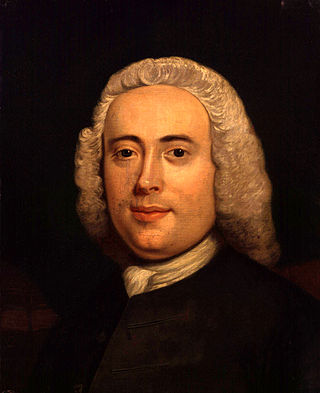
Gustav Robert Kirchhoff was a German physicist who contributed to the fundamental understanding of electrical circuits, spectroscopy, and the emission of black-body radiation by heated objects.

William Hyde Wollaston was an English chemist and physicist who is famous for discovering the chemical elements palladium and rhodium. He also developed a way to process platinum ore into malleable ingots.
The year 1821 in science and technology involved some significant events, listed below.
The year 1802 in science and technology involved some significant events, listed below.
The year 1860 in science and technology involved some significant events, listed below.
The year 1858 in science and technology involved some significant events, listed below.
The year 1854 in science and technology involved some significant events, listed below.

The year 1843 in science and technology involved some significant events, listed below.

John Canton was a British physicist. He was born in Middle Street Stroud, Gloucestershire, to a weaver, John Canton and Esther. As a schoolboy, he became the first person to determine the latitude of Stroud, whilst making a sundial. The sundial caught the attention of many, including Dr Henry Miles, a Stroud-born Fellow of the Royal Society. Miles encouraged Canton to leave Gloucestershire to become a trainee teacher for Samuel Watkins, the headmaster of a Nonconformist school in Spital Square, London, with whom he ultimately entered into partnership.

Jesse Ramsden FRS FRSE was a British mathematician, astronomical and scientific instrument maker. His reputation was built on the engraving and design of dividing engines which allowed high accuracy measurements of angles and lengths in instruments. He produced instruments for astronomy that were especially well known for maritime use where they were needed for the measurement of latitudes and for his surveying instruments which were widely used for cartography and land survey both across the British Empire and outside. An achromatic eyepiece that he invented for telescopes and microscopes continues to be known as the Ramsden eyepiece.

Peter Woulfe (1727–1803) was an Anglo-Irish chemist and mineralogist. He first had the idea that wolframite might contain a previously undiscovered element (tungsten).
Below are notable events in archaeology that occurred in 1859.

Lord Morton’s mare was an equid hybrid and once an often-noticed example in the history of evolutionary theory.
Events from the year 1802 in the United Kingdom.

Charles Brooke FRMS FRS was an English surgeon and inventor.
The Catalogue of Nebulae and Clusters of Stars (CN) is an astronomical catalogue of nebulae first published in 1786 by William Herschel, with the assistance of his sister Caroline Herschel. It was later expanded into the General Catalogue of Nebulae and Clusters of Stars (GC) by his son, John Herschel, in 1864. The CN and GC are the precursors to John Louis Emil Dreyer's New General Catalogue (NGC), compiled in 1888 and used by current astronomers.

Robert Wilhelm Eberhard Bunsen was a German chemist. He investigated emission spectra of heated elements, and discovered caesium and rubidium with the physicist Gustav Kirchhoff. The Bunsen–Kirchhoff Award for spectroscopy is named after Bunsen and Kirchhoff.

Sir Frederick John Owen Evans, was an officer of the Royal Navy. He became a distinguished hydrographer during his career and served as Hydrographer of the Navy.
Sir Arthur Herbert Church was a British chemist, expert on pottery, stones and chemistry of paintings, who discovered turacin in 1869 and several minerals, including the only British cerium mineral. He was also a talented artist and worked as a professor of chemistry at the Agricultural College in Cirencester and then at the Royal Academy of Arts. He wrote extensively on aspects of chemistry in agriculture, art, and daily life.

Modern spectroscopy in the Western world started in the 17th century. New designs in optics, specifically prisms, enabled systematic observations of the solar spectrum. Isaac Newton first applied the word spectrum to describe the rainbow of colors that combine to form white light. During the early 1800s, Joseph von Fraunhofer conducted experiments with dispersive spectrometers that enabled spectroscopy to become a more precise and quantitative scientific technique. Since then, spectroscopy has played and continues to play a significant role in chemistry, physics and astronomy. Fraunhofer observed and measured dark lines in the Sun's spectrum, which now bear his name although several of them were observed earlier by Wollaston.










